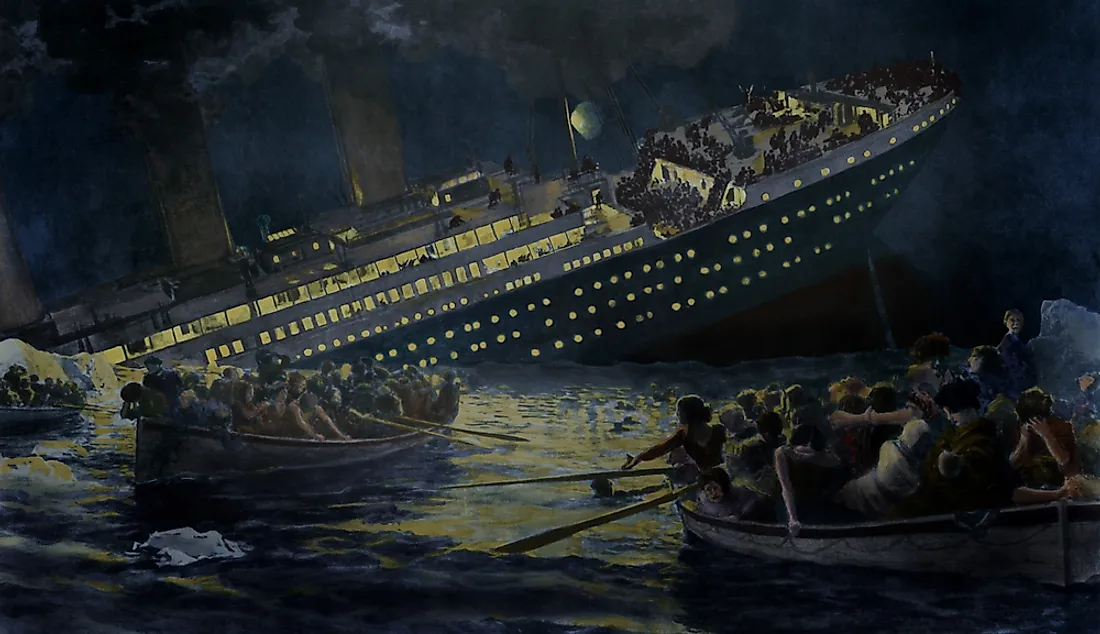When Did the Titanic Sink?

The RMS Titanic, operated by the White Star Line, was the largest ship of its time when it set afloat on its maiden voyage from Southampton, England to New York City on April 10, 1912. Said to be unsinkable, the Titanic shocked the world when it sank in the North Atlantic Ocean on April 14,1912. On board were 2,224 crew and passengers, 1,500 of whom perished in the ship's sinking. The ship’s architect, Thomas Andrews, and captain, Edward Smith, were among the casualties.
Discovery of the Site
The wreck of the Titanic was discovered as recently as 1985 by the use of modern technology employing a remote-controlled deep sea vehicle, the Argo, that was sent to the ocean depths to capture pictures of the ocean bottom without the need of manual diving into the waters. Prior to 1985, several expeditions were made in an attempt to locate the wreck of the famous ship but all attempts failed. The difficulty in locating the wrecks stemmed from the fact that the location last provided by the crew of the ship was actually 21.2 kilometers away from the actual site where the ship sank. This fact misled explorers for a long time till the wreck was finally discovered by the Argo, operated by a French-American team. The leaders of this team included the French oceanographer and engineer, Jean-Louis Michel of IFREMER and Robert Ballard, an ex-officer of the US Navy and a professor of oceanography in USA.
Salvage Efforts
The Titanic being one of the most famous and glorified ships of the 20th Century, continued to draw media and public attention for years after its unfortunate sinking. There was a great demand to salvage the Titanic and rescue its wreck and bodies from the depths of the dark ocean waters and display it on land as a reminder of its lost days of glory. Many of the passengers of Titanic being extremely wealthy had wealthy relatives who wanted the ship to be salvaged as a tribute to the memory of their lost loved ones. Hence, since the day the Titanic sank, several attempts were made to recover her wreck. A number of proposals were provided, many of them quite impractical in nature and often quite impossible and preposterous, like for example, lifting up the wreck by filling it up with ping pong balls or filling up the ship with liquid nitrogen that would make an iceberg out of the ship and raise it to the ocean surface. However, despite hundreds of ideas and plans, the exact location of the ship went undetected till 1985. Even after its discovery, the lack of finances and the location of the wreck at extreme depths in the Atlantic made is impossible to salvage the ship.
A Glimpse Into the Past
After leaving Southampton, the Titanic headed towards New York, stopping on its way at ports in France and Ireland. Four days into its journey, on April 4, 1912, the ship met with a terrible fate. 600 kilometers south off the coast of Newfoundland, the ship struck a giant iceberg that damaged its hull. 5 out of the 6 water tight compartments of the ship were damaged in the impact and seawater gradually started filling the ship. The crew of the ship understanding the grievousness of the situation, ordered for the lifeboats to be lowered with passengers. However, many of the lifeboats went down filled to only half their capacity. This mismanagement on the part of the crew of the RMS Titanic is still criticized heavily today. Women and children were the primary occupants of these lifeboats. Over 1000 passengers and crew members were still stranded on the ship as cold, seawater surged through it, broke the Titanic apart and finally sank the ship. Two hours after the Titanic foundered, the RMS Carpathia arrived at the site and managed to rescue only 705 passengers of the ill-fated ship.
Historical Significance and Legacy
After the sinking of Titanic, it was realized how false assumptions, over-confidence and improper management could lead to the death of so many innocent people. The ship lacked proper safety measures, did not have enough lifeboats nor conducted any safety drills to prepare its crew regarding management of emergency situations, communication with other ships was also mismanaged. Soon after the sinking, the Radio Act of 1912 was passed by the United States demanding the 24 hour operation of radio systems aboard passenger ships and in 1914, the International Convention for the Safety of Life at Sea was passed that made it mandatory to carry enough lifeboats on a ship for all the passengers on board and lifeboat drills and inspections were made compulsory. The International Ice Patrol was also set up after the disaster which continues to operate to this date, warning ships about icebergs on their way to avoid disasters like the Titanic's. The legacy of the Titanic also continues to influence popular culture. The first film on this disaster “Saved from the Titanic” was showcased only 29 days after the disaster. The most historically accurate film about the Titanic was “A Night to Remember”, a 1958 British film based on the 1955 book by the same name. The story of the Titanic again touched the hearts of millions when James Cameron released the 1997 film “Titanic” that won 11 Oscars at the 70th Academy Awards. Several monuments dedicated to the Titanic, statues of its famed passengers, museums artifacts from the Titanic also remind the world today about one of the greatest maritime disasters in the history of mankind.











